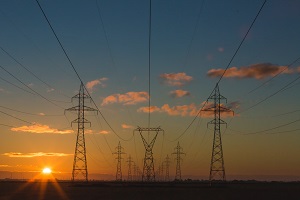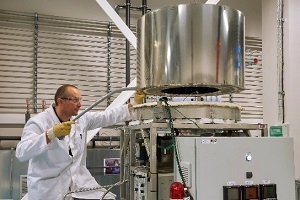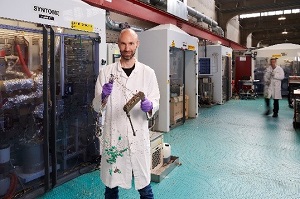lowcarbonenergy
Low-carbon energy production

To achieve our carbon-neutral objectives by 2050, the CEA is working on various building blocks of low-carbon energy production systems, i.e. supporting the current and future nuclear fleet through the development of small modular reactors (SMR), and conducting R&D on PV solar power and hydrogen.
Areas of research
Current nuclear reactors
The CEA conducts research to meet the challenges of the French nuclear industry. It helps to improve the competitiveness, safety and operating life of the French nuclear fleet, in support of EDF and Framatome. It also participates in the optimization of fuel cycle facilities in collaboration with Orano and Andra.
Nuclear fuel cycle
The research and development activities conducted at the CEA cover the entire nuclear fuel cycle, from uranium ore extraction to spent fuel processing and recycling of extracted materials, including management of the waste produced by these activities. The aim is to support industry and prepare the fuel cycle of the future with a view to a circular economy.
Solar power
All of the world's leading players (international agencies, governments, industry) agree that by 2040, solar photovoltaic will be the most installed source of energy in terms of power, which gives the market great visibility. This technology is one of the CEA's key areas of focus in terms of low-carbon energy production.
Hydrogen
Hydrogen technologies have been the subject of numerous research programs at the CEA since the end of the 1980's. They are part of the organization's missions in the development of new energies and rely in particular on expertise in terms of materials, high-temperature and high-pressure processes, and in terms of technology integration. The constant objective is to reinforce the economic interest of this energy vector and, for the CEA, to be at the forefront of hydrogen technologies in order to support industry.
SMRs
SMRs, or Small Modular Reactors, are small nuclear reactors with a power range of 50 to 500 MWe, compared to the 900 to 1450 MWe of a current French reactor. Their particularity is that they are modular: the different parts are designed to be mass-produced in a factory and then assembled on site. Responding to specific needs, this new range of reactors will complete the medium and high power nuclear offer and is currently meeting with strong interest worldwide. France and the CEA in particular are working on SMRs with the aim of commissioning them by 2030.
Future nuclear reactors
The CEA is conducting research on the nuclear reactors of the future in two main areas. The first is the development of compact reactors (SMR) based on French technology, to offer a more flexible nuclear power system that can be integrated into constrained electrical networks. In the longer term, the CEA is interested in so-called fourth-generation reactors, which will make it possible to close the fuel cycle by making better use of uranium resources and by proposing multi-recycling of plutonium while minimizing waste production.
Thermonuclear fusion to generate power
The CEA is one of the leading European research organisations in magnetic confinement fusion. It actively contributes to the European roadmap for research in this field. The international project called ITER has become the focus of this research, which brings together the European Union, Russia, the US, Japan, China, South Korea and India. Currently under construction next to the CEA Cadarache centre, this tokamak must demonstrate its ability to generate power through thermonuclear fusion reactions.
energycontrol
Energy system control and management

CEA is investigating tools that offer flexibility and energy storage methods, along with smart-load grid management and power conversion possibilities. It is specifically focusing on the performance and energy efficiency of complex energy systems.
Areas of research
Future energy networks
To meet the challenges of the energy transition and the goal of carbon neutrality by 2050, and to cope with the efficient integration of renewable energies into the energy mix and the growth of new uses, energy networks (heat, electricity, gas) must be rethought. From their architecture to their management, from components to systems, CEA teams are working alongside their industrial partners to design smarter, more resilient, more efficient and more economical networks.
Stationary energy storage systems
Energy storage technologies are an essential condition for the development of renewable energies and are the subject of major studies at CEA. At its CEA-Liten institute, researchers are working primarily on electrochemical storage (batteries), thermal storage and storage in the form of hydrogen.
Sustainable mobility
Achieving carbon neutrality by 2050, combating urban pollution, limiting energy dependence on critical raw materials, and gaining competitiveness are the major challenges of low environmental impact mobility, whether on the road, at sea or in the air. These are ambitious goals to which the CEA has been making a major contribution for more than 20 years, covering the entire R&D value chain, from materials and components to integrated systems. The CEA is involved in the design of vehicle powertrains as well as in energy production for electric mobility. It is also involved in the development of new generations of fuels that can replace fossil fuels.
circulareconomy
Circular economy

Optimisation of the nuclear fuel cycle phases, from extracting materials to managing nuclear waste, recycling atmospheric and industrial carbon dioxide, and reducing the environmental impact of technologies and energy systems from design: these are some of the circular economy challenges that the CEA is tackling through its research and development on the energy transition.
Areas of research
Nuclear fuel cycle
The research and development activities conducted at the CEA cover the entire nuclear fuel cycle, from uranium ore extraction to spent fuel processing and recycling of extracted materials, including management of the waste produced by these activities. The aim is to support industry and prepare the fuel cycle of the future with a view to a circular economy.
Carbon circular economy (CCE)
In a broad sense, the "circular carbon economy" refers to technologies enabling the production of carbon-based molecules and synthetic products useful in the energy, chemical and transport sectors, with favourable environmental and societal impacts. The CEA's research in this field is helping to achieve the goal of carbon neutrality by 2050, as set out in French law. The CEA is thus interested in all technologies for transforming carbon dioxide and its derivatives into synthetic products using low-carbon energy.
Materials circular economy
The energy and digital transitions could lead to replacing the current dependence on fossil fuels with a dependence on raw materials. Securing their supplies, limiting their environmental impact and making them more responsible are therefore major challenges. With its long-standing expertise and skills in the nuclear fuel cycle, the CEA has been integrating this circular economy approach to critical materials into its research programs for more than a decade and is involved in the entire life cycle of materials, from mining production to component recycling, with the aim of reintroducing them into a new manufacturing chain.